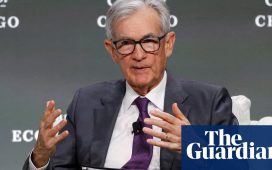UK inflation slows more than expected to 3.9%
Inflation in the UK slowed more than expected last month.
The annual inflation rate, measured by the consumer prices index, fell to 3.9% from 4.6% in October, the lowest since 2021, the Office for National Statistics said. Analysts had expected a reading of 4.4%.
In the year to November 2023:
▪️ Consumer Prices Index including owner occupiers’ housing costs rose by 4.2%, down from 4.7% in October
▪️ Consumer Prices Index (CPI) rose by 3.9%, down from 4.6% in October
➡️ https://t.co/RZCLXrRVqp pic.twitter.com/NA7C8hnrHY
— Office for National Statistics (ONS) (@ONS) December 20, 2023
Key events
Markets price in first rate cut as soon as March, FTSE 100 at 3-month high
Financial markets are now pricing in the first interest rate cut from the Bank of England by May, possibly as soon as March.
The FTSE 100 index has hit a three-month high, as investors cheered the surprisingly large drop in inflation.
The FTSE 100 jumped 1.3% to 7,738.
The pound dropped 0.6% below $1.27, as reported earlier.
Meanwhile, James Smith, developed markets economist at ING, said:
UK inflation has come in much lower than expected for November and markets are now pricing a whopping 140bp of cuts next year. That’s maybe pushing it, but investors are right to be thinking about several cuts next year, despite the Bank of England’s recent pushback.
Interestingly, this data has also seen investors reassess where the BoE stands relative to the Fed and European Central Bank. Up until now, markets had been expecting both of the latter to be much more aggressive than the BoE, but that narrative seems to be fading.
One thing we’ve often heard recently is that UK inflation (specifically services) is stickier and therefore that implies slower/later rate cuts relative to the eurozone. We wrote in more detail recently why a lot of the divergence in UK services inflation relative to the continent can be explained by factors not intrinsically linked to economic conditions. In the areas that really count for monetary policy – things like hospitality – the differences are much less dramatic.
So while the BoE might be a little later to the cutting game than other European economies, we don’t expect the UK to be an outlier when it comes to the extent of policy easing.
Opinion is divided on what the data means for UK interest rates.
Yael Selfin, chief economist at KPMG UK, said:
Today’s data will bolster the Bank of England’s argument that it remains too early to consider cutting interest rates, particularly with core inflation significantly above levels consistent with the inflation target.
The core inflation rate dipped to 5.1%, far above the central bank’s 2% inflation target.
Helen Morrissey, head of retirement analysis at Hargreaves Lansdown, said:
CPI has taken a tumble hitting 3.9% in November. This is the lowest it’s been in more than two years and a bigger drop than expected. After years of unrelenting pressure on our budgets such a fall will be greeted with real relief.
The price of fuel was a major contributor to the drop as prices of petrol and diesel fell back. Food too was a major factor – fuelled by falls in bread and cereals where prices dropped 0.8% on the month, compared with a rise of 1.9% a year ago. The price of meat, milk, cheese and eggs also eased though it’s worth saying that food prices still remain high by historical standards.
Looking more widely this news has bigger implications for our finances. Such a drop could be taken as a sign that the Bank of England has gone as far as it needs to in its interest rate hiking cycle. Keeping the pause button pressed will be welcome news for those on variable rate mortgages who have seen their costs rise as well as those with credit card debt. Fixed rate mortgages could fall slightly, as the prospect of further rate rises fades but we’re not expecting any big moves until the market starts to expect a rate cut – which could be some time off yet.
It’s a welcome fall but it’s worth saying inflation remains higher than other countries such as Germany and well above the Bank’s 2% target. Things can also change rapidly – if we see fuel prices spike again or a strong growth in wages, then we could still see a rate rise. Similarly, if the economy looks to be weakening, we could see a rate cut materialise sooner than we think.
Shadow chancellor Rachel Reeves said:
The fall in inflation will come as a relief to families. However, after 13 years of economic failure under the Conservatives, working people are still worse off.
Prices are still going up in the shops, household bills are rising, and more than a million people face higher mortgage payments next year after the Conservatives crashed the economy.
Jeremy Hunt: ‘There’s still further to go’ on tackling inflation
The UK chancellor, Jeremy Hunt, said there was “still further to go” on tackling inflation, after the surprisingly large fall to 3.9% in November.
He told reporters:
There’s still further to go. Inflation never falls in a straight line.
In a statement, he explained:
With inflation more than halved we are starting to remove inflationary pressures from the economy. Alongside the business tax cuts announced in the autumn statement this means we are back on the path to healthy, sustainable growth.
But many families are still struggling with high prices so we will continue to prioritise measures that help with cost of living pressures.
Bread, cake, meat, milk, cheese and eggs become cheaper
Let them eat cake! Prices of a number of bread products, including white and wholemeal sliced loaves, and packs of cakes all fell between October and November, but rose a year ago.
Other smaller downward contributions to the change in the inflation rate came from meat; milk, cheese and eggs; and soft drinks. The only partially offsetting upward effect came from fruit, where prices of strawberries rose this year by more than a year ago.
Sterling slipped below $1.27 “as a kneejerk reaction to the softer-than-expected inflation figures”, according to an analyst.
The pound is trading 0.6% lower against the dollar at $1.2653, and has fallen 0.4% against the euro to €1.1546, as the inflation numbers put pressure on the Bank of England to lower interest rates.
Inflation in the eurozone slowed to 2.4% in November and core inflation fell to 3.6% as expected.
In the UK, both headline and core inflation fell faster than expected in November. Headline inflation slipped below the 4% mark, while core inflation, which excludes volatile items like food and energy, eased to 5.1%.
Ipek Ozkardeskaya, senior analyst at Swissquote Bank, explained:
Yet in absolute terms, core inflation in Britain is still more than twice the Bank of England’s 2% inflation target. And even though the pace of easing is more than welcome, the Bank of England is still last in line to join the pivot party.
Therefore, hawkish BoE expectations should limit the pound selloff if, of course, investors continue to divest from the US dollar on the back of softening Fed expectations.
Food prices rise 9.2%, lowest rate since May 2022
Back to the breakdown.
Second-hand car prices fell by 2.1% between October and November, a bigger fall than last year, while prices of roadside recovery services were also down, but rose a year ago.
Air fares fell as usual between October and November. This year, they fell by 13.9%, compared with 10.1% a year ago.
Also down were prices of games, toys and hobbies, particularly computer games, and cultural services, especially theatre and live music event tickets.
In even better news, food and non-alcoholic drink prices rose by 0.3% between October and November, compared with a rise of 1.1% a year ago. The annual rate eased for an eighth moth to 9.2%, the lowest since May 2022. It compares with a recent high of 19.2% in March, which was the highest annual rate for more than 45 years.
Simon French, chief economist at Panmure Gordon, tweeted:
Those arguing over summer that the UK was on a sustained & higher inflation path to the rest of the developed world starting to look a bit daft. It was clear in the data that the timing of the energy cost passthrough was central to the UK decoupling. Outsized disinflation in H2… https://t.co/pP6dKQpPB4
— Simon French (@shjfrench) December 20, 2023
ONS chief economist Grant Fitzner said:
Inflation eased again to its lowest annual rate for over two years, but prices remain substantially above what they were before the invasion of Ukraine.
The biggest driver for this month’s fall was a decrease in fuel prices after an increase at the same time last year. Food prices also pulled down inflation, as they rose much more slowly than this time last year.
There was also a price drop for a range of household goods and the cost of second-hand cars.
Factory gate prices remain little changed over the past year, while on an annual basis the change in costs that producers pay for raw materials and fuel was negative for the sixth consecutive month.
Inflation slowdown caused by drop in petrol prices
The slowdown in inflation was caused by a drop in petrol prices, while second-hand cars, maintenance and repairs, and air fares also dragged the figure down.
The average price of petrol fell by 4.1 pence per litre between October and November to 151p per litre, down from 163.6p per litre in November 2022. Diesel prices fell by 3.2p per litre this year to 159p, down from 187.9p per litre in November 2022.
Overall, motor fuel prices fell by 10.6% in the year to November, compared with a fall of 7.6% in the year to October.
Prices fell by 0.2% between October and November compared with a monthly rise of 0.4% a year earlier.
The annual inflation rate was the lowest since September 2021, and down from a recent peak of 11.1% in October 2022, which was the highest rate in over 40 years, as energy and food prices surged.
Here is our first take on the surprising large fall in inflation:
UK inflation slows more than expected to 3.9%
Inflation in the UK slowed more than expected last month.
The annual inflation rate, measured by the consumer prices index, fell to 3.9% from 4.6% in October, the lowest since 2021, the Office for National Statistics said. Analysts had expected a reading of 4.4%.
In the year to November 2023:
▪️ Consumer Prices Index including owner occupiers’ housing costs rose by 4.2%, down from 4.7% in October
▪️ Consumer Prices Index (CPI) rose by 3.9%, down from 4.6% in October
➡️ https://t.co/RZCLXrRVqp pic.twitter.com/NA7C8hnrHY
— Office for National Statistics (ONS) (@ONS) December 20, 2023
UK inflation data to show whether cost of living crisis is easing
Good morning, and welcome to our rolling coverage of business, the financial markets and the world economy.
The latest inflation data will shed some light on whether Britain’s cost of living crisis is easing.
UK inflation is expected to have slowed to an annual rate of 4.4% in November, from 4.6% in October, according to analysts’ forecasts. The Office for National Statistics will release the figures at 7am GMT.
Core inflation, which strips out volatile items like food and energy, is forecast to have dipped to 5.6% from 5.7%.
In October, consumer price inflation fell sharply from 6.7% to 4.6%, reflecting a monthly fall in gas and electricity costs this year whereas last year there was a steep rise, but prices for food, other goods, and services all eased back too.
Sandra Horsfield, UK economist at Investec, explained:
That said, declaring victory over inflation remains a more remote prospect in the UK than in the US or indeed the eurozone, both of which are visibly closer to target inflation, with lower ‘core’ inflation too. The pain this entails for households is clear, which the Bank of England is all too aware of. This month, we expect to see further evidence that inflation is heading back down again. But that progress is likely to be fairly gradual.
Food and energy price inflation is likely to have contributed again – the latter this time because of falling petrol prices, not due to changes in utility bills, which are adjusted only quarterly. We also see scope for inflation for certain goods prices to keep easing: certainly, producer price inflation figures suggests there is plenty of scope for this in the months to come. But it is not uniform; base effects in clothing and footwear prices, for instance, look unfavourable, as there was already a large drop last year.
Still, ‘core’ prices for goods and also services actually reflect some energy costs too, where these are embedded into production costs. It is therefore likely that the significant retracement in wholesale energy costs, even if to historically still fairly high levels, is helping to push core inflation down too.
For the Bank of England, the downtrend trend in inflation is likely to be perceived as too gradual to allow for rate cuts in the very near term, especially considering the jobs market still looks reasonably robust. We continue to expect a first move down in interest rates only in August 2024.
The Agenda








